Best Time to Send an Email (According to Top Email Tools)
Has it ever happened to you that you sent a business email and the recipient missed it because it appeared in their inbox at the wrong time?
If yes, then you understand the importance of scheduling your email messages to make sure your recipients receive them when it’s most convenient for them.
But how can you figure this out?
We’ve collected six studies from top-rated email marketing platforms suggesting the best days and times to send emails. Let’s see what they have to say.
Why Does Timing Matter When Sending an Email?
More often than not, people follow a certain pattern when checking their email. If you reflect a bit, you’ll also realize that you scroll through your inbox a few times throughout the day, and it mostly happens when you arrive at work in the morning and open your computer.
Apart from that, most inboxes are pretty cluttered. According to Earthweb, an average person receives around 100 emails. So, the chances that your message will get lost or accidentally deleted are pretty high.
All of this confirms that timing is extremely important when sending an email, and if you get it right, you’ll be able to see a bunch of positive changes in the performance of your email marketing campaign in terms of the core metrics, which we’re going to look at next.
P.S. If you want to learn more about email marketing KPIs, check out this guide.
4 Metrics to Measure the Performance of Your Emails
Before we jump to discussing the most optimal time to send an email based on the studies from different email marketing platforms, we’d like to go over the main metrics that indicate the success (or failure) of your efforts.
The metrics that show the performance of your email sends include the open rate, conversion rate, click-through rate, and click-to-open rate. Let’s discuss them in more detail.
Email metric #1: Open rate
Email open rate is a metric that indicates the percentage of recipients that opened your email vs. the total number of recipients.
Here’s the formula for it:
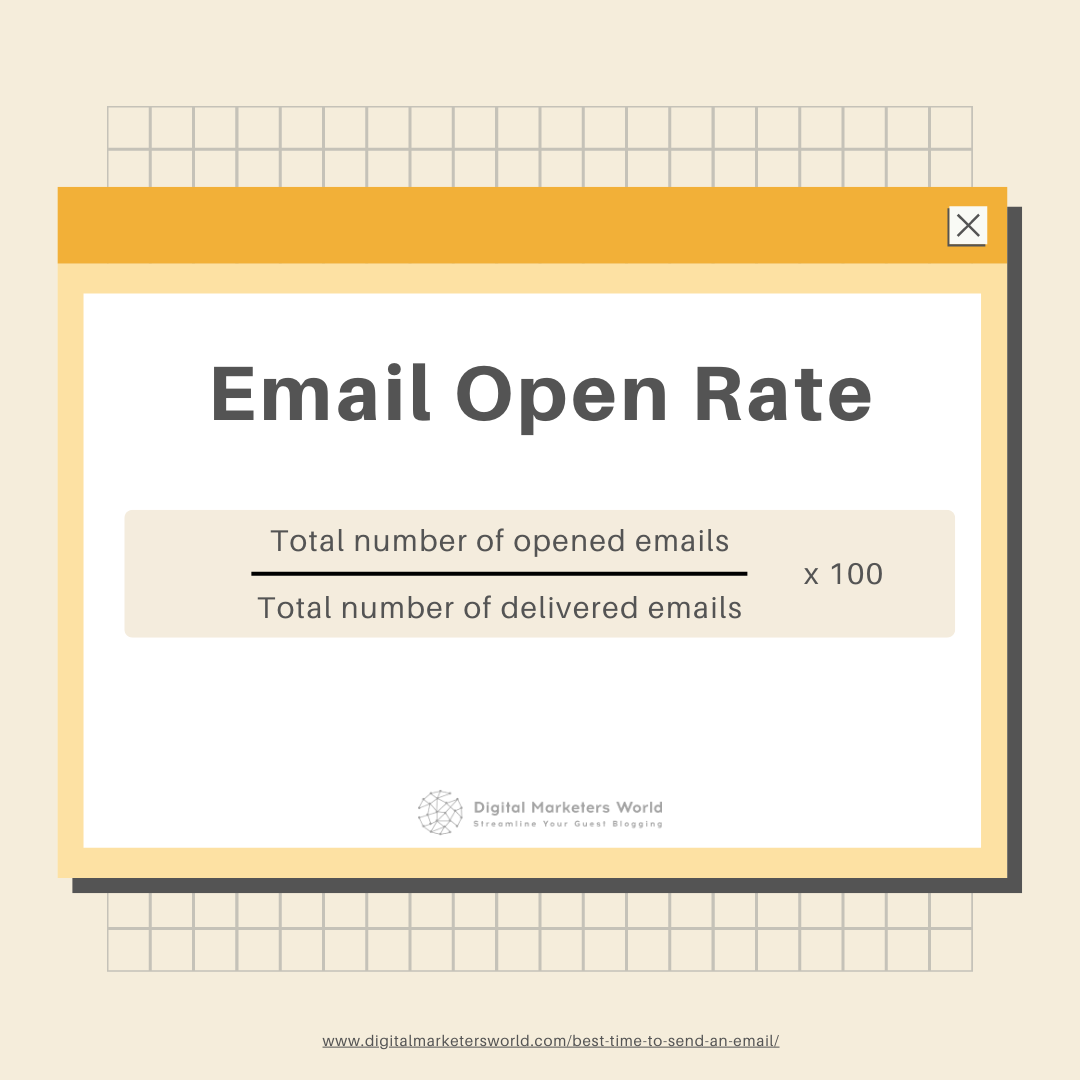
According to Campaign Monitor, the average indicator for this KPI for all industries is 21.5%. However, we could say that if your percentage falls somewhere between 15%-20%, you can rest assured that your email marketing campaign is doing fine.
But let’s go back to the main question – what’s the connection between the open rate and the time you send your emails?
Although we don’t recommend assessing the success of your efforts through only one email marketing KPI, this metric can be the first sign that your email schedule isn’t correct. Essentially, if most of your subscribers haven’t opened your message, it could mean that it was delivered at the wrong time.
However, apart from the sending schedule, you should also review other factors that could impact your open rates, such as:
- Subject line. Try not to make it too generic. Instead, focus on personalization, leverage the FOMO and the sense of urgency (avoid sounding too spammy – it will cause a high bounce rate and low email deliverability), and use pre-header text to provide some context.
- Inactive subscribers. Sometimes, when businesses purchase and don’t verify lead lists properly, they can experience low open rates because some of the addresses in those email lists have been inactive for a while.
- Email blasts. An attempt to bombard your recipients with multiple emails won’t resolve the problem of low email opens. Instead, you should focus on the content you include in your message – it should cater to the needs of your target audience.
We’d also add that this metric can drop if your email isn’t optimized for mobile devices.
Email metric #2: Conversion rate
Email conversion rate is the percentage of recipients who’ve completed the action indicated in your email out of the total number of subscribers.
The formula to calculate this metric is the following:
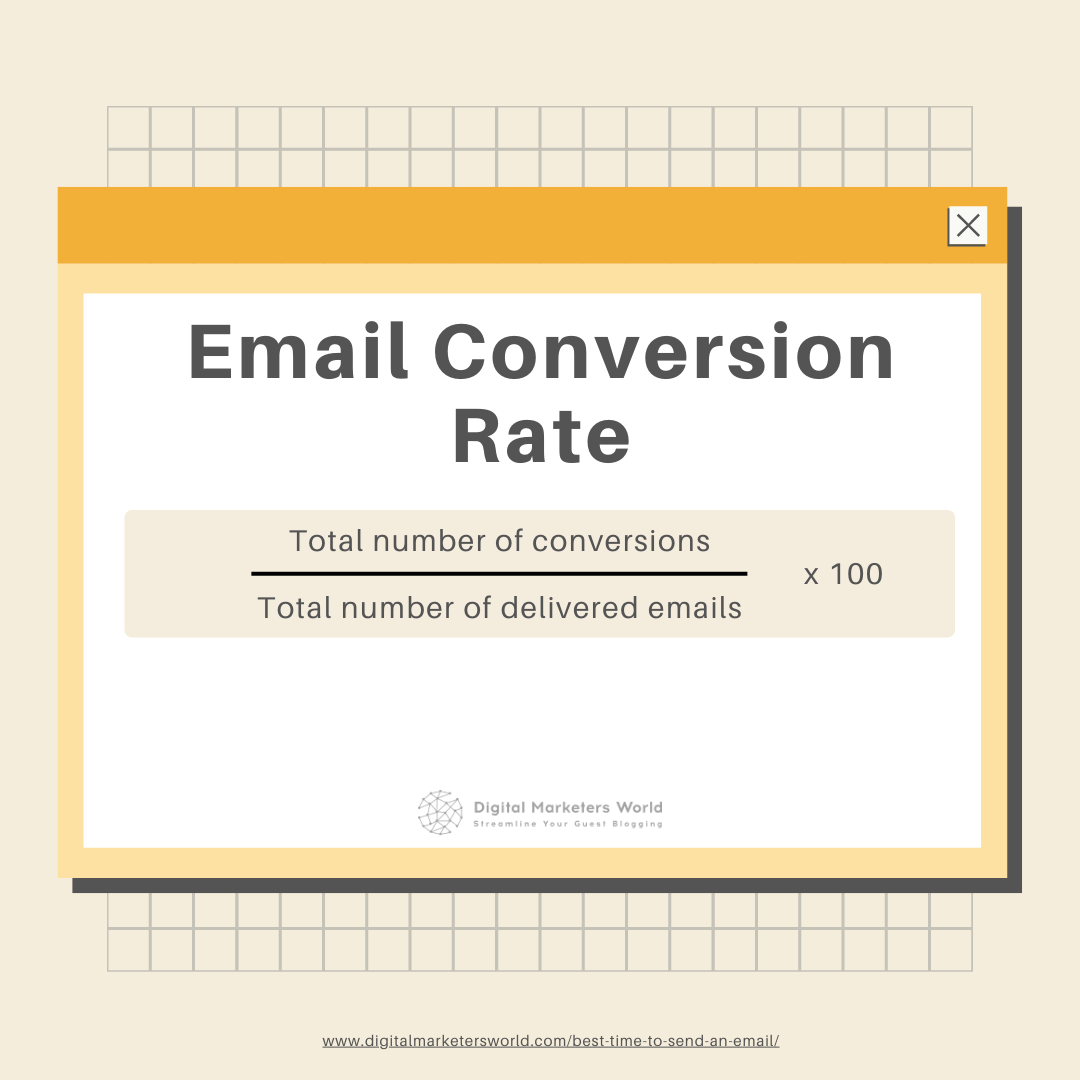
A good conversion rate is around 15%, says Active Campaign. This data comes from the brand’s 2020 research, which also indicates that the average conversion rate in 2018 was 19%. So, we can assume that, as of 2022, the point that you should strive for is between 10%-15%.
The time when the email is sent is not the most significant factor impacting conversion rates, but it can help improve the email’s visibility and the chances that the recipient reads through it and takes action.
The most crucial factor connected to this KPI is, in fact, email content. If it goes heavy on personalization, has a responsive design, and includes compelling call-to-actions, chances are that the subscribers will do what you ask them to. Another factor that plays a deciding role is subscriber segmentation – it ensures that you send an email to the right people at the right customer journey stage.
Email metric #3: Click-through rate
Email click or click-through rate (CTR) describes the percentage of recipients who clicked on a CTA button, an image, or anything within the body of the email that contains a hyperlink. This percentage is divided by the total number of emails sent minus the number of bounces.
Here’s the formula:
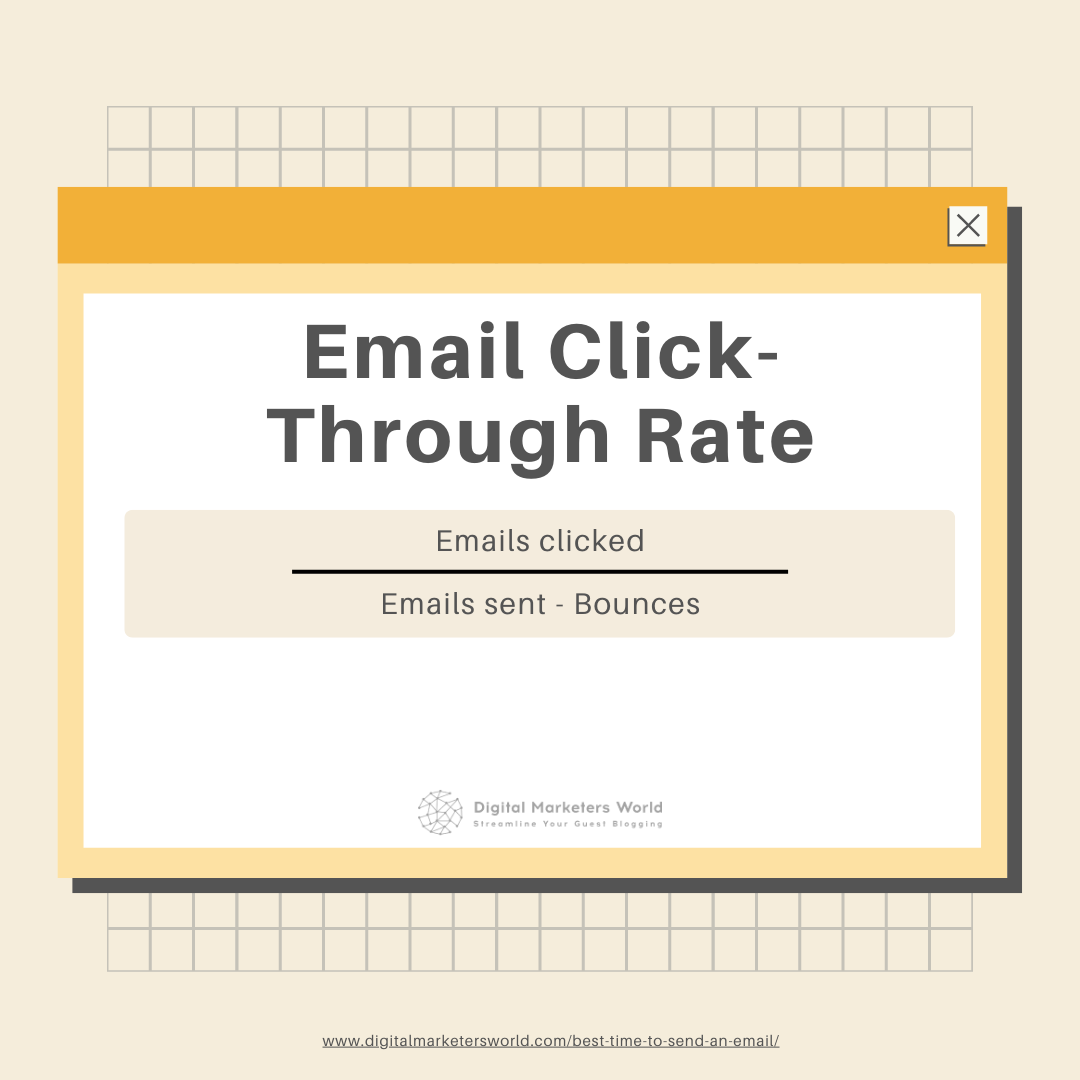
Mailchimp says that the average email click rate is 2.62%, but for some industries, such as Media & Publishing, Hobbies, and Religion, the average percentage is even higher – about 5%.
CTR is the KPI that reflects the engagement of your email. So, we can confidently say that your sending schedule can also impact it significantly – if the email is delivered at the right time, the click-through rate can improve.
However, similar to conversion rates, this email marketing metric also depends on the content – personalization and responsive design will ensure the best email performance.
However, note that overstuffing your email with links will do more harm than good – a recipient should have a clear destination to go to if you want them to convert. In case you still have to include several links, make sure to run an A/B test to see how your focus groups respond.
Email metric #4: Click-to-open rate
Click-to-open rate (CTOR) is the percentage of recipients who opened your email and then clicked on the links in it. Next, you need to divide this rate by the total number of unique email opens and multiply the result by 100.
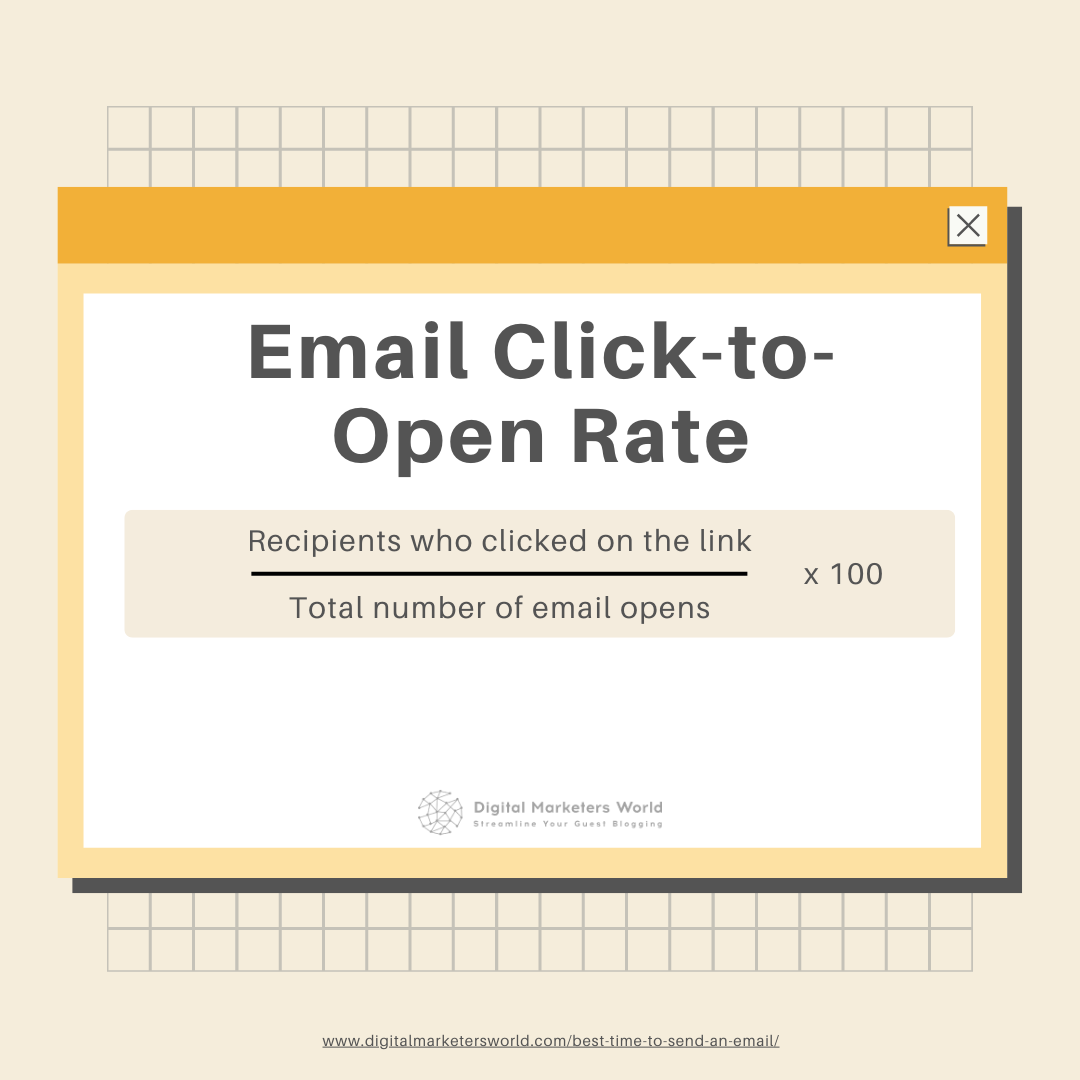
You might have noticed that this metric is similar to the open rate, and it is. However, it also includes the element of the CTR, which is about the percentage of link clicks.
It’s very easy to spot the connection between the times you send your emails and this KPI – the more precise you are about your schedule, the higher the chances that more recipients will open and click through the message.
Keep in mind, though, that some other factors can result in a lower CTOR. For instance, poorly written and not personalized email subject lines can be the reason why people leave your emails unopened. By the way, we have a really good guide on the best email newsletter practices that will help you boost this and other metrics – make sure to give it a read.
Alright, now you have a better idea of the connection between the time to send an email and various metrics. However, there are other, broader aspects to consider before you start distributing your emails. We’ll take a look at them in the following section.
3 Factors to Consider When Sending an Email
After this section, we will discuss some research pieces from different email marketing automation tools, but we want to warn you right away – they are just templates, and you shouldn’t follow them blindly.
Why?
Although their numbers are more or less correct, they are just one piece of the puzzle. To have a full picture of when to send your emails, you should also consider three deciding factors that will help you make an informed decision in your particular case.
Let’s discuss them in more detail.
Factor #1: Audience
Who are your recipients?
Knowing the answer to this question can help you pinpoint the right time to send the emails. Here, you want to consider the following aspects.
First, think about the demographics of your target audience. If most of your subscribers are between 25 to 35, you can assume that they will most likely see and click on your message in the inbox in the morning around nine or ten when they get to work. However, if we’re talking about college students, the most appropriate email timing will probably shift to the evening when they’re done with their classes.
Another factor related to the demographics is the location and time zone. If some of your email subscribers come from the EU and others from the US, you need to do audience segmentation and send the same email at different times.
If you’re doing B2B email marketing, you also need to pay attention to the industry and niche your target recipient works in.
Finally, it’s important to consider the devices your recipients use to check the inbox and other behavioral data that you would also use for email retargeting – all this information is essential to get the right time to send emails.
Factor #2: Industry
As we’ve already mentioned here and there, each industry has its own email marketing benchmarks. For instance, when we referred to the Mailchimp study, we noted that some industries have higher click-through rates. This is also true for other metrics, like unsubscribe rates and hard and soft bounces.
The same applies to email scheduling as well. Depending on the industry and what an email campaign offers, the best time of day can also differ significantly, and we’ll talk about it in more detail later.
Factor #3: Season
To optimize your schedule, you shouldn’t forget about seasonality.
Let’s look at an example to help you understand what we mean. Here is a promotional email from Grammarly that we also mentioned in our article on email marketing examples.
If you take a closer look, you will see that the promotion is related to the Black Friday sale. Emails like this usually do better when you send them during a specific time of year. We can compare it to Christmas or Thanksgiving sales which most E-commerce and SaaS companies do at that time of year.
So, if your email is of commercial value, and you want it to have higher open, click-through, and conversion rates, consider the seasonality factor.
The Best Time to Send an Email According to Top Email Tools
Alright, now let’s review six email service providers and their research regarding the best time and day for email send-outs.
Here, we want to remind you once again that these research results are generalized, and you should consider your email metrics and factors such as audience, seasonality, and industry before deciding on the schedule.
However, if it’s your first time ever to launch an email marketing strategy, you can use these findings as a foundation and work your way forward:
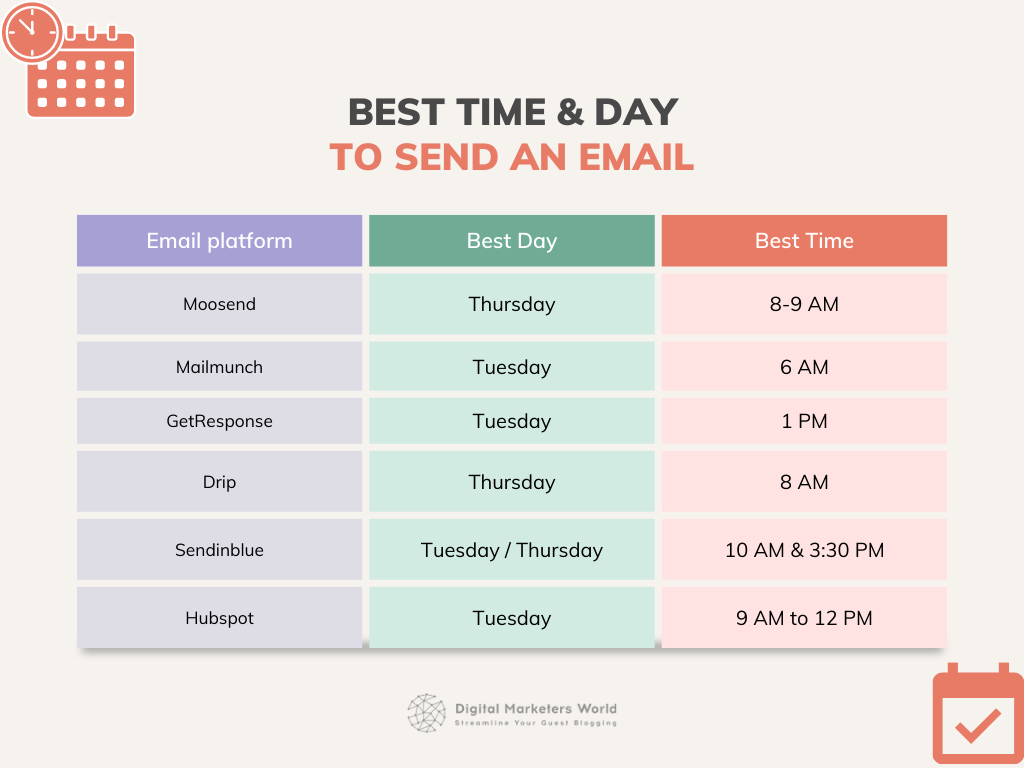
Now, let’s talk about each of these case studies in more detail.
Platform #1: Moosend
The platform obtained the following data from its research:
- Best day to send emails – Thursday
- Best time to send emails – 8-9 am
You’d think that Monday would be perfect to start sending your messages since many people return to work on this day and the first thing they do is check their inboxes.
Yet, Moosend found that Thursday brings higher open rates. However, if it’s not the option for you, you can also try Tuesday – it’s second-best performance-wise. However, Saturday or Sunday are the worst days- the chances that your email will be opened are at their lowest on weekends compared to the workweek. You can see it for yourself from this graph:
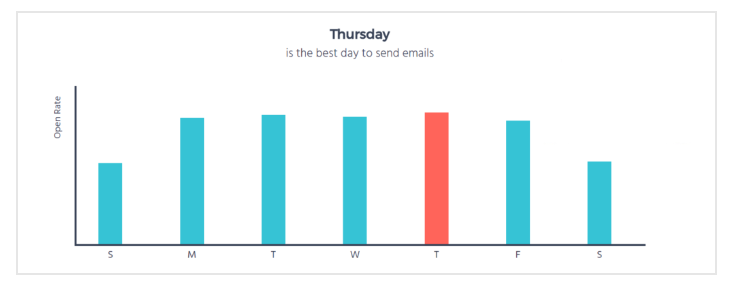
When it comes to the times, Moosend recommends going for the time slot before work hours, somewhere between 8 am and 9 am. However, we can also see here that the activity starts peaking at 6-7 am, so you can also go for this time of the day:
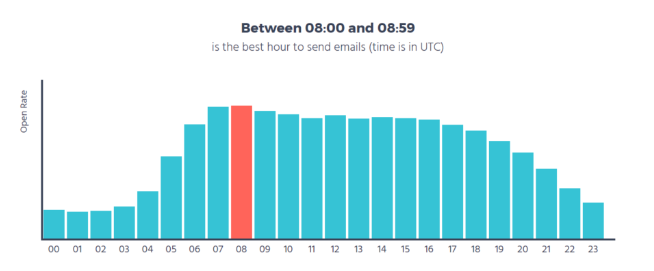
We can also notice that the decline begins at around 5 pm – 6 pm, so it’s better not to go for this time slot. Late night and the early hours of the morning are also no-go.
Now, let’s see if Mailmunch’s findings are similar.
Platform #2: Mailmunch
Here’s what this email marketing platform has discovered:
- Best day to send emails – Tuesday
- Best time to send emails – 6 am
Okay, so here, Mailmunch somewhat agrees with Moosend that Tuesday is a good day to send your emails. However, its research states that Thursday is the second-best time of the week for this task, while Moosend’s study claimed otherwise – Thursday is best and Tuesday is second-best.
Overall, Mailmunch claims that midweek (Tuesday, Wednesday, and Thursday) will all work. It’s also worth mentioning that, according to this study, Wednesday shows consistently high open rates.
Speaking about time, Mailmunch states that the first peak time happens at 6 am. However, they did a bit of digging and came up with the best times to send emails by day:
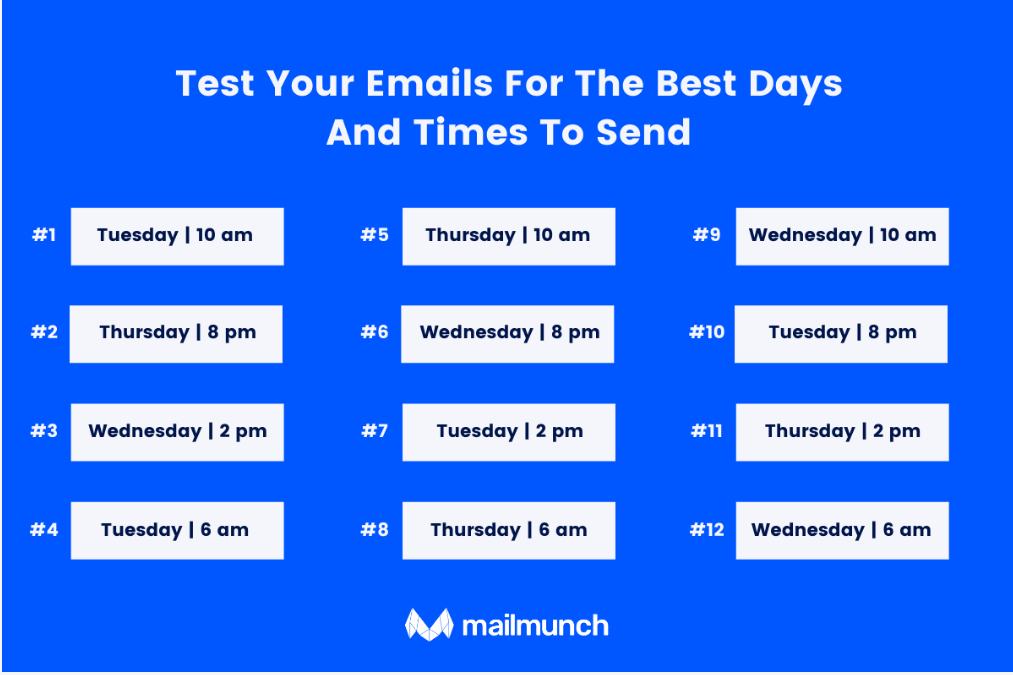
Here, we see a ranking of the best workdays and times to schedule emails. The best day and time is, of course, Tuesday 10 am, while Wednesday at 6 am is the least suitable option. You can also see that Monday, Friday, and the weekend don’t appear on the list.
By the way, Mailmunch confirms our claims that people mostly check their emails once they arrive at work – around 9-10 am. The platform doesn’t recommend including lunch break times in the schedule but states that evening hours (7-10 pm) can work.
Off to the next research piece on our list.
Platform #3: GetResponse
After analyzing a whopping 4 billion emails between January and June 2019, GetResponse found the following (as republished by OptinMonster):
- Best day to send emails – Tuesday
- Best time to send emails – 1 pm
As we can see, GetResponse is on the same page with Mailmunch, confirming that the best day to schedule emails is Tuesday. However, from the graph below, we can also see that the email performance in terms of open rate, click-through rate, and click-to-open rate remains more or less stable on all weekdays, with slight fluctuations on Tuesday and Thursday:
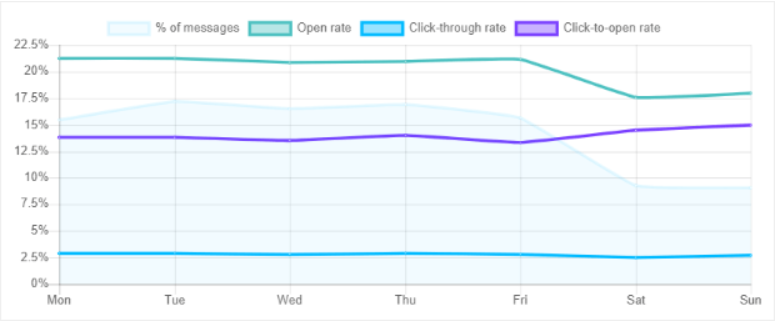
So, we can assume that the middle of the week works best.
When it comes to time, 1 pm is indeed the perfect time of the day to send your emails. However, here we can also see that the graph starts peaking in the early morning (5-6 am), and the activity remains relatively high until 3 pm:

o, a logical conclusion would be to schedule your emails within the 6 am – 2 pm time slot.
Now, let’s see what Drip has to suggest.
Platform #4: Drip
Drip’s data covers mostly the best time of the week:
- Best day to send emails – Thursday
This email marketing platform schedules all emails to go out on Thursday, which is confirmed by the information provided by Drip’s Google Analytics:
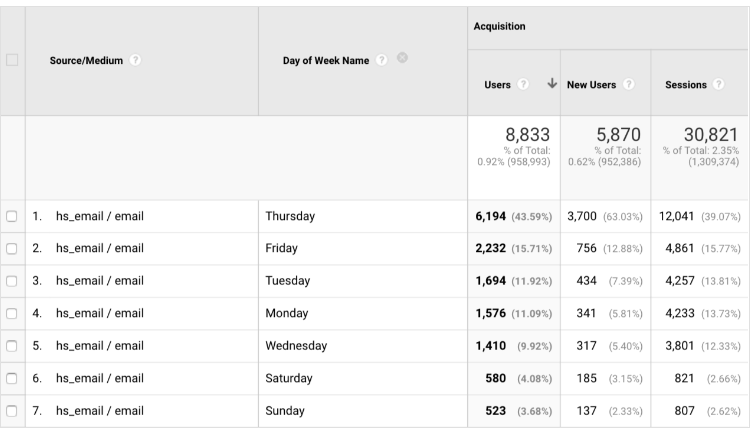
We can see that most users open the emails on Thursdays, and this day also delivers the most sessions. Besides, this time of the week also brings the most new users from email (as a channel) to Drip’s website.
But what about timing?
Overall, this study sets 8 am as a rule of thumb but also claims it’s irrelevant since recipients are located in different time zones. In this regard, Drip recommends doing a split test to determine the best hour to schedule your emails.
Now, let’s investigate Sendinblue’s findings.
Platform #5: Sendinblue
Sendinblue is a bit more specific about its data:
- Best days to send emails – Tuesday and Thursday
- Best times to send emails – 10 am and 3:30 pm
As we can see, Sendinblue’s results are consistent with the previous two studies we discussed. Tuesday and Thursday are great if you want to boost email opens. You can also opt for Wednesday, as it has the best click-through rates. Judging from the graph below, the next best option would be Monday, as it has a decent open rate volume:
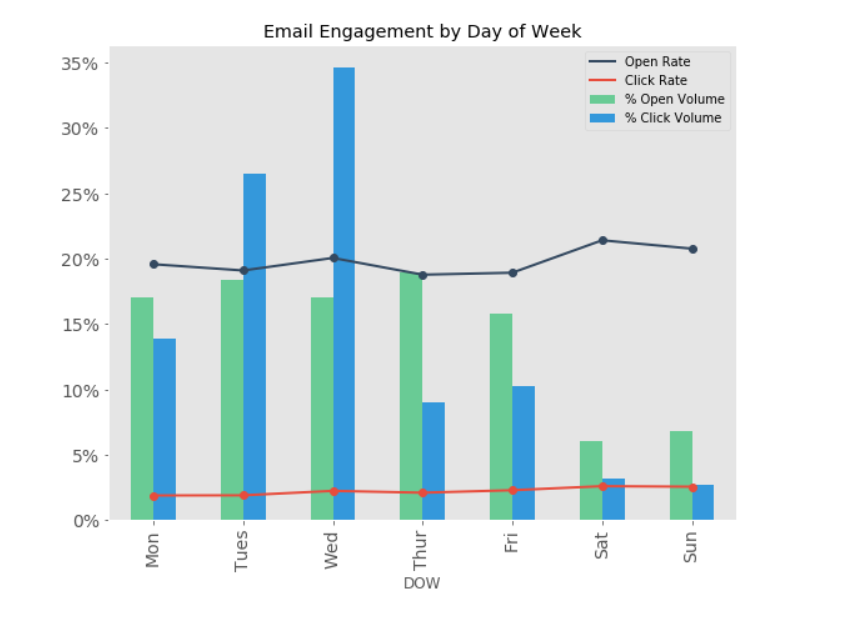
As for the time, Sendinblue recommends going for 10 am or 3:30 pm, as these slots have shown the most consistent performance regarding open and click-through rates. However, from the graph below, we can see that the activity starts growing at 7 am, confirming what the previous studies have also found:

And if you need more industry-specific data, Sendinblue has prepared it for you too:
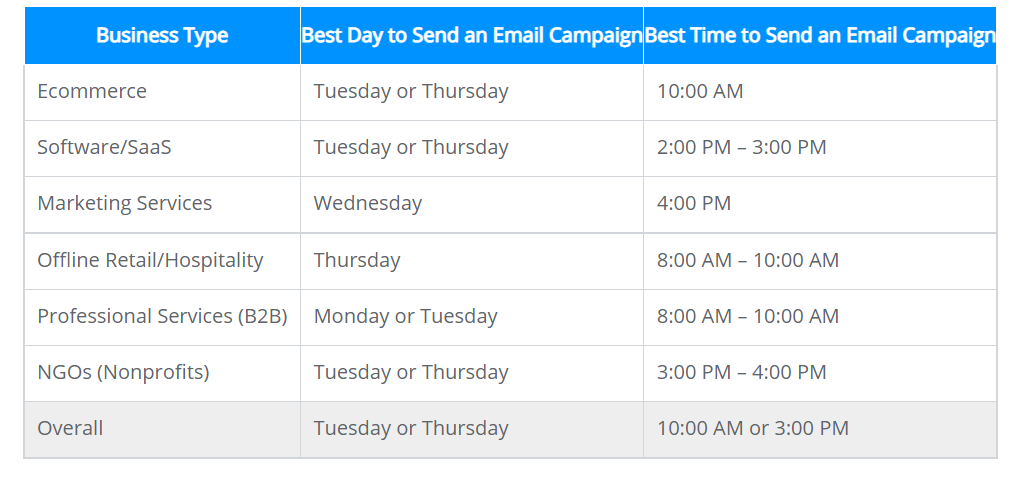
Remember – your industry is one of the deciding factors to help you choose the best day of the week and time to schedule emails, so make sure to take this information into account.
It’s time for our final study.
Platform #6: Hubspot
The platform ran a survey of over 300 marketers in the U.S. and found the following:
- The best day to send emails – Tuesday
- The best times to send emails – 9 am to 12 pm
Here, we can also notice the consistency with other research pieces on our radar. The survey results confirm that Tuesday shows the highest email engagement, with 24.9% of respondents confirming it. The next best days are Monday (with 22.6% of supporters) and Wednesday (21.3% of marketers).
In terms of timing, HubSpot doesn’t provide a specific hour but says that most marketers send emails between 9 am and 12 pm. Others prefer to do it between 12 pm and 3 pm:
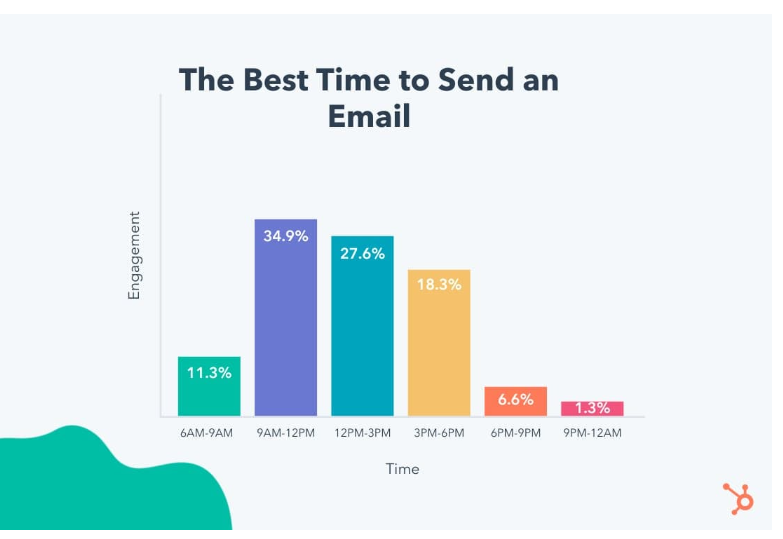
The platform also highlights the importance of remaining audience-specific when choosing the right time of day to send an email. You can use this data as a starting point but don’t rely solely on it, as it might not work for your personas.
The Bottom Line
So, as a takeaway from all that we discussed above, the best day and time to schedule emails would be Tuesday or Thursday between 9 am and 12 pm.
All the marketing services agree, saying that these days bring the highest open rates, while Wednesday is great if you want to increase your CTR. As for the send time, user activity starts peaking in the morning and remains relatively high till noon. However, it’s always recommended to run A/B tests or do split testing to make the final decision.
Did you like this article?
Make sure to check out other posts on our blog – we have many helpful guides for digital marketers!

Mariia is a content strategist and editor at Digital Marketer’s World. She is passionate about educating others on all things marketing and believes in the power of the written word.
